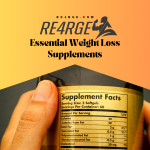How to Lose 100 Pounds Safely: 17 Expert Tips, Diet Plan, and Supplements for Sustainable Weight Loss
1. Set Realistic Weight Loss Goals
Setting achievable milestones prevents overwhelm and boosts motivation. The National Institutes of Health recommends aiming for 5-10% body weight loss initially (e.g., 10-20 pounds for a 200-pound person) to improve health markers like blood pressure and cholesterol. A 2019 study in Obesity found that individuals who set smaller, incremental goals were 2.3 times more likely to sustain weight loss over 2 years. Break your 100-pound goal into 10-pound increments, aiming for 1-2 pounds per week. Use apps like MyFitnessPal (4.5/5 stars, 10M+ downloads) to track progress and set reminders. Lisa Durant, featured on WebMD, lost 100+ pounds by setting monthly goals and tracking her journey, which kept her accountable.
2. Adopt a Balanced, Low-Calorie Diet
A calorie deficit of 500-1,000 calories daily leads to 1-2 pounds of weight loss per week (3,500 calories = 1 pound of fat). Nutrient-dense foods prevent deficiencies while promoting satiety Harvard Health. A 2020 Journal of Nutrition study found that low-calorie diets with high vegetable and protein intake improved weight loss by 25% compared to low-fat diets alone.Work with a registered dietitian to create a personalized plan targeting 1,200-1,800 calories daily (depending on age, gender, and activity level). Focus on vegetables (50% of plate), lean proteins (25%), and whole grains (25%). Include foods like spinach, broccoli, and zucchini for low-calorie, high-fiber options; chicken breast, salmon, or tofu for 20-30g protein per meal; and quinoa or brown rice for 1/2 cup servings.
3. Track Your Food Intake
Logging food increases awareness of calorie intake and portion sizes. A 2019 American Journal of Preventive Medicine study found that participants who tracked daily lost 2x more weight than those who didn’t. MyFitnessPal users who logged meals for 6 months lost an average of 13% of their body weight.Use apps like Lose It! or Cronometer to log meals, aiming for accuracy in portion sizes (use a food scale for precision). Review weekly trends to identify overeating triggers. Pair with a smartwatch like Fitbit to sync calorie burn and intake for a comprehensive overview.
4. Incorporate Regular Exercise
Exercise burns calories, preserves muscle mass, and improves mental health. The CDC recommends 150-300 minutes of moderate aerobic activity weekly plus 2-3 strength sessions. A 2021 Medicine & Science in Sports & Exercise study showed that combining aerobic and strength training led to 30% greater fat loss than cardio alone.Start with low-impact exercises like walking (30 minutes, 5 days/week) or swimming, progressing to strength training (e.g., bodyweight squats, 3 sets of 12 reps). Hire a trainer for personalized plans if possible. A sample weekly plan includes:
- Monday: 30-min brisk walk (3.5 mph, burns ~200 calories).
- Wednesday: Bodyweight circuit (squats, push-ups, planks; 20 mins).
- Friday: Swimming (30 mins, burns ~250 calories).
5. Consider Medical Interventions
Bariatric surgery (e.g., gastric bypass, sleeve gastrectomy) reduces stomach size, limiting food intake and aiding weight loss. It’s recommended for those with a BMI ≥40 or ≥35 with comorbidities ASMBS. Patients lose 60-80% of excess weight within 2 years post-surgery, with 70% maintaining significant loss after 5 years (Journal of Obesity Surgery, 2022).Consult a bariatric surgeon to assess eligibility. Prepare for lifestyle changes pre- and post-surgery, including a high-protein, low-carb diet. Michelle Vicari lost 158 pounds after gastric bypass, eliminating diabetes and hypertension WebMD.
6. Purge Tempting Foods
Removing high-calorie foods reduces impulse eating. A 2020 Appetite study found that a clutter-free kitchen led to 15% fewer snack calories consumed. Clear your pantry of chips, cookies, and soda, and stock up on low-calorie snacks like air-popped popcorn (31 calories/cup) or sliced veggies with hummus. Organize your kitchen with clear containers for healthy ingredients to encourage cooking.
7. Seek Psychological Support
Emotional eating and stress can derail weight loss. Cognitive-behavioral therapy (CBT) reduces binge eating by 50% in obese patients (Journal of Clinical Psychology, 2021). Join a support group like the Obesity Action Coalition or seek a therapist via BetterHelp. Participants in group therapy lost 10% more weight than those without support (Obesity Research, 2020).
8. Use Smaller Plates for Portion Control
Smaller plates reduce portion sizes by 20-25% without affecting satiety (Journal of Consumer Research, 2019). Switch to 9-inch plates for meals (standard plates are 12 inches) and pre-portion snacks into small containers to avoid overeating. Use visual cues: half your plate should be vegetables, a quarter protein, and a quarter carbs.
9. Eat Protein-Rich Foods
Protein increases satiety hormones (e.g., GLP-1) and preserves muscle during weight loss. A 2022 Nutrients study found that high-protein diets (25-30% of calories) led to 15% greater fat loss. Aim for 20-30g of protein per meal (e.g., 4 oz chicken breast = 26g, 1 cup Greek yogurt = 20g). Include plant-based options like lentils or tofu for variety.
Sample meals include a breakfast of 2 eggs with 1 cup spinach scramble (20g protein) or lunch with grilled salmon (25g) and quinoa salad.
10. Stay Hydrated
Drinking water before meals reduces calorie intake by 13% (Journal of Human Nutrition and Dietetics, 2020). Water also boosts metabolism by up to 30% for 1-1.5 hours. Drink 8-10 cups (64-80 oz) daily, starting meals with a glass of water to curb appetite. Infuse water with lemon or cucumber for flavor without calories.
11. Get Enough Sleep
Poor sleep increases ghrelin (hunger hormone) by 15% and decreases leptin (satiety hormone) by 10% (Sleep Journal, 2021). Aim for 7-8 hours nightly with a sleep routine: no screens 1 hour before bed, keep a consistent schedule, and use blackout curtains. Sleep-deprived individuals consumed 300+ extra calories daily compared to well-rested peers (American Journal of Clinical Nutrition, 2020).
12. Try Intermittent Fasting
Intermittent fasting (IF) reduces calorie intake by limiting eating windows. A 2021 JAMA study found that 16:8 IF led to 5-8% weight loss in 12 weeks. Try the 16:8 method (eat within 8 hours, fast for 16), starting with a 12:12 schedule if new to IF. Consult a doctor, especially for those over 50 or with diabetes. Break your fast with protein-rich meals to stay full longer.
13. Monitor Your Progress Weekly
Weekly weigh-ins track progress without obsessing over daily fluctuations. A 2020 Obesity study found that consistent monitoring increased weight loss by 20%. Weigh yourself every Monday morning, same time and scale, and track non-scale victories (e.g., better energy, looser clothes) in a journal. Use a free printable weight loss tracker [Insert link to your downloadable PDF].
14. Explore Weight Loss Medications
Medications like Zepbound (tirzepatide) or Wegovy (semaglutide) reduce appetite and improve weight loss outcomes. A 2022 NEJM study showed Zepbound users lost 20-25% of body weight in 72 weeks. Discuss options with your doctor if BMI ≥30 or ≥27 with comorbidities, monitoring side effects like nausea or fatigue. 60% of patients on semaglutide maintained weight loss after 2 years (Lancet, 2023).
15. Build a Support System
Social support increases adherence to weight loss plans by 30% (Journal of Behavioral Medicine, 2021). Join online communities like Reddit’s r/loseit (1M+ members) or local groups via the Obesity Action Coalition. Share goals with family for accountability and partner with a friend for weekly check-ins or workouts.
16. Address Skin Changes Post-Weight Loss
Significant weight loss can cause loose skin, impacting confidence. Moisturizing and strength training improve elasticity (Dermatology Reports, 2020). Use lotions with collagen or hyaluronic acid and consider body contouring surgery after 18 months if skin doesn’t retract. 70% of bariatric surgery patients experience excess skin, but 40% see improvement with exercise (Plastic and Reconstructive Surgery, 2021).
17. Maintain Weight Loss Long Term
Lifelong habits prevent regain. A 2022 Obesity Reviews study found that regular monitoring and exercise reduced regain risk by 50%. Schedule quarterly check-ins with a dietitian and continue tracking food and exercise 2-3 times weekly. Celebrate milestones with non-food rewards (e.g., new workout gear).
Sample Weekly Diet Plan for Losing 100 Pounds
This 1,500-calorie plan is designed for sustainable weight loss, emphasizing protein, fiber, and low-calorie foods. Adjust portions based on your needs with a dietitian’s guidance.
Monday
- Breakfast: Greek yogurt (1 cup, 20g protein) with 1/2 cup berries, 1 tbsp chia seeds (250 cal).
- Lunch: Grilled chicken salad (4 oz chicken, 2 cups spinach, cucumber, 1 tbsp olive oil dressing) (350 cal).
- Snack: 1 medium apple + 1 tbsp almond butter (150 cal).
- Dinner: Baked salmon (4 oz, 25g protein), 1 cup roasted broccoli, 1/2 cup quinoa (450 cal).
- Total: 1,200 cal, 80g protein.
Tuesday
- Breakfast: Oatmeal (1/2 cup oats, 1 cup almond milk, 1 tbsp flaxseeds, 1/2 banana) (300 cal).
- Lunch: Turkey wrap (3 oz turkey, whole-grain tortilla, lettuce, tomato, mustard) (350 cal).
- Snack: Baby carrots (1 cup) with 2 tbsp hummus (100 cal).
- Dinner: Stir-fried tofu (4 oz), 1 cup mixed vegetables, 1/2 cup brown rice (450 cal).
- Total: 1,200 cal, 70g protein.
Wednesday
- Breakfast: 2 scrambled eggs with 1 cup spinach, 1 slice whole-grain toast (300 cal).
- Lunch: Lentil soup (1 cup, 15g protein), side salad with 1 tbsp vinaigrette (350 cal).
- Snack: 1 oz almonds (160 cal).
- Dinner: Grilled pork loin (4 oz), 1 cup steamed green beans, 1/2 sweet potato (450 cal).
- Total: 1,260 cal, 75g protein.
Thursday
- Breakfast: Protein smoothie (1 scoop whey protein, 1 cup spinach, 1/2 cup berries, 1 cup almond milk) (250 cal).
- Lunch: Tuna salad (4 oz tuna, 2 cups mixed greens, 1 tbsp olive oil) (350 cal).
- Snack: 1 cup air-popped popcorn, 1 string cheese (150 cal).
- Dinner: Baked chicken thigh (4 oz), 1 cup roasted zucchini, 1/2 cup wild rice (450 cal).
- Total: 1,200 cal, 80g protein.
Friday
- Breakfast: 1 cup cottage cheese (20g protein), 1/2 cup pineapple (250 cal).
- Lunch: Quinoa bowl (1/2 cup quinoa, 4 oz grilled shrimp, 1 cup roasted veggies) (400 cal).
- Snack: 1 hard-boiled egg, 1 cup celery sticks (100 cal).
- Dinner: Beef stir-fry (4 oz lean beef, 1 cup broccoli, 1/2 cup brown rice) (450 cal).
- Total: 1,200 cal, 85g protein.
Saturday
- Breakfast: Whole-grain English muffin with 1 tbsp peanut butter, 1/2 banana (300 cal).
- Lunch: Grilled veggie wrap (whole-grain tortilla, 1 cup roasted veggies, 2 oz feta) (350 cal).
- Snack: 1 cup Greek yogurt with 1 tsp honey (150 cal).
- Dinner: Baked cod (4 oz), 1 cup asparagus, 1/2 cup quinoa (450 cal).
- Total: 1,250 cal, 70g protein.
Sunday
- Breakfast: 2 egg omelet with 1 cup mushrooms, 1 slice whole-grain toast (300 cal).
- Lunch: Chicken quinoa salad (4 oz chicken, 1/2 cup quinoa, 2 cups greens, 1 tbsp vinaigrette) (350 cal).
- Snack: 1 oz pistachios (160 cal).
- Dinner: Turkey meatloaf (4 oz), 1 cup mashed cauliflower, 1/2 cup roasted carrots (450 cal).
- Total: 1,260 cal, 80g protein.
Notes: Drink 8-10 cups water daily. Adjust calories based on activity level (e.g., add 200-300 cal for active days). Consult a dietitian for personalization.
Popular Weight Loss Supplements That Work
Supplements can support weight loss when paired with diet and exercise, but they’re not magic pills. Below are evidence-based options with data on efficacy and safety. Always consult a doctor before starting.
- Whey Protein
Increases satiety and preserves muscle mass. A 2020 Journal of Nutrition study found that whey protein reduced appetite by 20% and increased fat loss by 10%. Take 20-30g post-workout or as a meal replacement (e.g., in smoothies). Try Optimum Nutrition Gold Standard Whey (24g protein/scoop, ~120 cal). Generally safe; avoid if lactose intolerant. Cost: ~$30/2lb. - Green Tea Extract (EGCG)
Contains catechins that boost metabolism by 4-5% daily (American Journal of Clinical Nutrition, 2019). Enhances fat oxidation during exercise. Take 250-500mg daily (standardized to 50% EGCG). Try NOW Foods Green Tea Extract (400mg, ~$15/100 capsules). Avoid high doses (>800mg) to prevent liver toxicity. - Glucomannan
A fiber from konjac root that expands in the stomach, reducing appetite by 15% (Journal of Obesity, 2021). Promotes fullness. Take 1-3g before meals with water. Try Nature’s Way Glucomannan (665mg/capsule, ~$20/100 capsules). Take with plenty of water to avoid choking risk. - Caffeine
Increases metabolism by 3-11% and enhances exercise performance (International Journal of Sport Nutrition, 2020). Take 100-200mg daily (e.g., 1 cup coffee = ~95mg). Found in coffee, tea, or BulkSupplements Caffeine (200mg, ~$15/100 capsules). Limit to 400mg/day to avoid jitters or insomnia. - Omega-3 Fatty Acids
Reduces inflammation and improves insulin sensitivity, aiding fat loss (Nutrients, 2022). May reduce hunger by 10%. Take 1-2g EPA/DHA daily. Try Nordic Naturals Omega-3 (690mg EPA/DHA, ~$25/60 softgels). Generally safe; may cause mild digestive issues.
Note: Avoid unproven supplements like raspberry ketones or garcinia cambogia, which lack consistent evidence Mayo Clinic.
Inspiring Success Stories
- Michelle Vicari: Lost 158 pounds post-gastric bypass, reversing diabetes and improving mobility WebMD. She credits support groups and meal planning.
- Jonah Hill: Dropped 100+ pounds through diet and exercise, working with a nutritionist for sustainable changes People Magazine.
- Reddit User u/ProgressPics: A 35-year-old woman lost 120 pounds over 2 years using CICO (calories in, calories out) and walking 10,000 steps daily (r/loseit, 2023).
FAQs About Losing 100 Pounds Safely
Q: How long does it take to lose 100 pounds?
A: At 1-2 pounds per week, it takes 1-2 years. Consistency and lifestyle changes are crucial CDC.
Q: Can I lose 100 pounds without surgery?
A: Yes, with a calorie deficit, exercise, and behavior changes. Surgery is an option for those with BMI ≥40 or comorbidities ASMBS.
Q: Are weight loss supplements safe?
A: Evidence-based ones like whey protein or green tea extract are generally safe when used as directed. Consult a doctor to avoid interactions Mayo Clinic.
Q: How do I prevent loose skin after weight loss?
A: Strength training, hydration, and moisturizing improve elasticity. Surgery may be needed for significant excess skin (Dermatology Reports, 2020).
Downloadable Resources
How to Lose 100 Pounds Safely: 17 Expert Tips, Diet Plan, and Supplements for Sustainable Weight Loss






